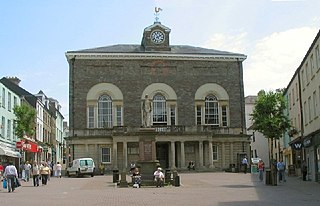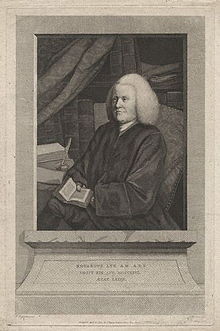Old English, or Anglo-Saxon, is the earliest recorded form of the English language, spoken in England and southern and eastern Scotland in the early Middle Ages. It was brought to Great Britain by Anglo-Saxon settlers in the mid-5th century, and the first Old English literary works date from the mid-7th century. After the Norman conquest of 1066, English was replaced, for a time, by Anglo-Norman as the language of the upper classes. This is regarded as marking the end of the Old English era, since during this period the English language was heavily influenced by Anglo-Norman, developing into a phase known now as Middle English in England and Early Scots in Scotland.

Totnes is a market town and civil parish at the head of the estuary of the River Dart in Devon, England, within the South Devon Area of Outstanding Natural Beauty. It is about 5 miles (8.0 km) west of Paignton, about 7 miles (11 km) west-southwest of Torquay and about 20 miles (32 km) east-northeast of Plymouth. It is the administrative centre of the South Hams District Council.

Eadburh was the daughter of King Edward the Elder of England and his third wife, Eadgifu of Kent. She lived most of her life as a nun known for her singing ability. Most of the information about her comes from hagiographies written several centuries after her life. She was canonised twelve years after her death and there are a small number of churches dedicated to her, most of which are located near Worcestershire, where she lived.
Æthelnoth was the archbishop of Canterbury from 1020 until his death. Descended from an earlier English king, Æthelnoth became a monk prior to becoming archbishop. While archbishop, he travelled to Rome and brought back saint's relics. He consecrated a number of other bishops who came from outside his archdiocese, leading to some friction with other archbishops. Although he was regarded as a saint after his death, there is little evidence of his veneration or of a cult in Canterbury or elsewhere.

George Hickes was an English divine and scholar.

Sir Robert Taylor (1714–1788) was an English architect and sculptor who worked in London and the south of England.

Æthelwold of Winchester was Bishop of Winchester from 963 to 984 and one of the leaders of the tenth-century monastic reform movement in Anglo-Saxon England.

Oswald of Worcester was Archbishop of York from 972 to his death in 992. He was of Danish ancestry, but brought up by his uncle, Oda, who sent him to France to the abbey of Fleury to become a monk. After a number of years at Fleury, Oswald returned to England at the request of his uncle, who died before Oswald returned. With his uncle's death, Oswald needed a patron and turned to another kinsman, Oskytel, who had recently become Archbishop of York. His activity for Oskytel attracted the notice of Archbishop Dunstan who had Oswald consecrated as Bishop of Worcester in 961. In 972, Oswald was promoted to the see of York, although he continued to hold Worcester also.

Franciscus Junius, also known as François du Jon, was a pioneer of Germanic philology. As a collector of ancient manuscripts, he published the first modern editions of a number of important texts. In addition, he wrote the first comprehensive overview of ancient writings on the visual arts, which became a cornerstone of classical art theories throughout Europe.

Wigmore is a village and civil parish in the northwest part of the county of Herefordshire, England. It is located on the A4110 road, about 8 miles (13 km) west of the town of Ludlow, in the Welsh Marches. In earlier times, it was also an administrative district, called a hundred.
Richard Burthogge (1637/38–1705) of Devon, England, was a physician, magistrate and philosopher.

William Somner (1598–1669) was an English antiquarian scholar, the author of the first dictionary of the Anglo-Saxon language.
Edward Thwaites (Thwaytes) was an English scholar of the Anglo-Saxon language. According to David C. Douglas he was "one of the most inspiring teachers which Oxford has ever produced".
Ælfric Bata was a monk and a disciple of Ælfric of Eynsham at Winchester some time before 1005. The epithet Bata is unclear; the formerly accepted interpretation "the bat" has been rejected, and Tengvik suggests it means 'stout'.

Bryan Faussett was an English antiquary. Faussett formed a collection that was rich in Anglo-Saxon objects of personal adornment, such as pendants, brooches, beads and buckles. He discovered the Kingston Brooch, the largest known Anglo-Saxon composite brooch. At the time of his death he had the world's largest collection of Anglo-Saxon items.
Owen Manning (1721–1801) was an English clergyman and antiquarian, known as a historian of Surrey.
Philip Furneaux (1726–1783) was an English independent minister.

Ann Fisher was an English author and grammarian. A New Grammar, which appeared in 1745, made her the earliest published female author on modern English grammar, although Elizabeth Elstob had published a grammar of Anglo-Saxon in 1715.

Edward Yarde (1669–1735), of Churston Court in the parish of Churston Ferrers in Devon was a Member of Parliament for Totnes in Devon 1695-1698.

Colin Robert Chase was an American academic. An associate professor of English at the University of Toronto, he was known for his contributions to the studies of Old English and Anglo-Latin literature. His best-known work, The Dating of Beowulf, challenged the accepted orthodoxy of the dating of the Anglo-Saxon poem Beowulf, which had settled on a date in the latter half of the eighth century, and left behind what was described in A Beowulf Handbook as "a cautious and necessary incertitude".













